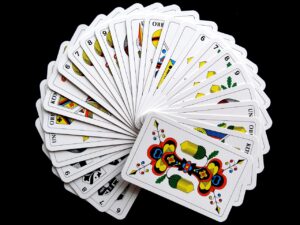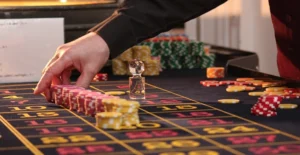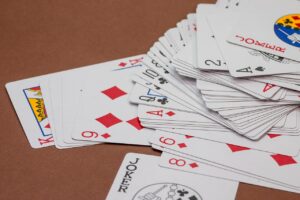Crazy Rummy, a fun card game, can seem a bit wild at first. But with a few pointers, anyone can get the hang of it. This guide breaks down the basics, from setting up your first game to understanding how to win. We’ll cover what makes Crazy Rummy unique and how to play smart. Get ready to learn the rules for Crazy Rummy and start playing like a pro.
Key Takeaways
- Crazy Rummy involves making sets and runs of cards, similar to other rummy games.
- Understanding the role of wild cards is important for effective play and scoring.
- Players draw, meld, and discard cards in turns to form valid combinations.
- The goal is to be the first to empty your hand, but minimizing penalty points is key to winning overall.
- Different variations of Crazy Rummy exist, each with slight rule changes.
What Is Crazy Rummy? An Overview of the Game
Crazy Rummy is a card game that takes the familiar elements of traditional Rummy and adds a few twists to make things more interesting. If you’re looking for a game that’s easy to learn but offers plenty of room for strategy, this might be it. The main goal, like in most Rummy games, is to get rid of all your cards by forming them into valid combinations, called melds. These melds are typically sets of cards with the same rank or runs of cards in sequential order. The game gets its ‘crazy’ name from the specific rules and potential for unexpected turns.
Understanding how to play Crazy Rummy involves grasping the basic mechanics of drawing, melding, and discarding, but also paying attention to special card functions and scoring. It’s a game that rewards careful planning and a bit of adaptability. Many people enjoy it because it’s not just about luck; your decisions do matter.
Key Concepts in Crazy Rummy
- Melds: These are the core of the game. You’ll be trying to create sets (three or four cards of the same rank, like three 7s) and runs (three or more cards of the same suit in sequence, like 4, 5, 6 of hearts).
- Wild Cards: Crazy Rummy often features wild cards, which can stand in for any other card to help complete a meld. Knowing how to use these effectively is a big part of winning.
- Discard Pile: After drawing a card, you must discard one from your hand. This discard is placed face-up, and the next player can choose to take the top card from the discard pile or draw from the stock.
- Going Out: The round ends when a player successfully melds all their cards and has no cards left in their hand.
Crazy Rummy Setup: Cards, Players, and Game Structure

Getting started with Crazy Rummy is pretty straightforward. You don’t need a whole lot of fancy equipment, just a standard deck of cards and a few friends. The number of players can change the feel of the game, so keep that in mind when you’re gathering your group.
Deck and Players
Crazy Rummy is typically played with a standard 52-card deck. Some variations might include jokers, but for the basic game, just the 52 cards will do. The game is best enjoyed with anywhere from two to six players. More players can make the game more dynamic, but it can also slow things down a bit.
Game Structure
Crazy Rummy is played over a series of rounds. The goal of each round is to be the first player to get rid of all the cards in your hand by forming valid melds. The game continues until one player reaches a predetermined score, or until all players agree to end the game. The scoring system is what makes Crazy Rummy interesting, as it penalizes players for the cards left in their hands at the end of each round.
Dealing the Cards
The dealer shuffles the deck and deals cards one at a time to each player. The number of cards dealt depends on the number of players. For example, in a two-player game, each player might receive ten cards. In games with more players, the number of cards dealt per player might be reduced to keep the game moving. After dealing, the remaining cards form the stockpile, and the top card is turned face-up to start the discard pile.
Objective of the Game
The main goal in Crazy Rummy is to arrange your cards into valid combinations, known as melds. These melds are either sets (three or four cards of the same rank) or runs (three or more cards of the same suit in sequential order). Once you have melds, you can lay them down on the table. The first player to successfully meld all their cards and discard their final card wins the round. It’s a game that requires a bit of strategy and a good memory for what cards have been played. Learning the crazy rummy card game rules is key to success.
Remember, the game isn’t just about making your melds; it’s also about strategically managing your hand and the discard pile to prevent your opponents from doing the same. Paying attention to what others are collecting can give you a significant edge.
Card Values for Scoring
While not strictly part of the setup, understanding how cards are valued for scoring purposes is important from the start. Face cards (King, Queen, Jack) are typically worth 10 points each. Number cards are worth their face value, except for Aces, which can be worth either 1 point or 11 points depending on the specific rules being used for runs. This scoring system directly impacts how you approach melding and discarding throughout the game. For instance, holding onto high-value cards might be risky if you can’t meld them quickly. It’s a bit like deciding when to Let It Ride in poker; you have to weigh the potential reward against the risk of holding onto those cards.
Understanding Melds: Sets and Runs in Crazy Rummy
In Crazy Rummy, the core of winning revolves around forming specific combinations of cards known as melds. These melds are the building blocks for emptying your hand and scoring points. There are two primary types of melds you’ll be working with: sets and runs.
Sets
A set, sometimes called a ‘book,’ is a collection of three or four cards that all share the same rank. For instance, three 7s (7 of hearts, 7 of diamonds, 7 of clubs) or four Kings (King of spades, King of hearts, King of diamonds, King of clubs) would both qualify as valid sets. The suits of the cards within a set do not matter, only their rank.
Runs
A run, also referred to as a ‘sequence,’ consists of three or more cards that are in consecutive rank order and belong to the same suit. For example, the 4, 5, and 6 of spades would form a valid run. Similarly, the Jack, Queen, King, and Ace of hearts could also be a run, provided the Ace is used as a high card in this specific instance. Remember, in most standard Rummy games, the Ace can be high or low, but not both in the same run (e.g., King-Ace-2 is not a valid run). The key to forming a valid run is that all cards must be of the same suit and in sequential rank.
Here’s a quick breakdown of what makes a meld valid:
- Sets: Three or four cards of the same rank (e.g., 8-8-8 or Q-Q-Q-Q).
- Runs: Three or more consecutive cards of the same suit (e.g., 3♥-4♥-5♥ or 10♠-J♠-Q♠-K♠).
It’s important to get these combinations right, as incorrectly formed melds won’t count and can even lead to penalties. Understanding how to create these sets and runs in Crazy Rummy is your first step toward mastering the game.
Dealing and Turn Order: How to Begin a Game
Getting a Crazy Rummy game started involves a few simple steps. First, you’ll need a standard 52-card deck. The dealer shuffles the deck and then deals cards to each player. The number of cards dealt depends on how many people are playing. Generally, more players mean fewer cards per person to keep the game moving.
Here’s a breakdown of the card distribution:
- Two players: Each receives 10 cards.
- Three or four players: Each receives 7 cards.
- Five or six players: Each receives 6 cards.
After dealing, the remaining cards form the draw pile, placed face down in the center. The top card of the draw pile is turned face up next to it to start the discard pile. If the draw pile runs out during play, all cards from the discard pile, except the top one, are shuffled to create a new draw pile. This ensures the game can continue without interruption.
Determining the Dealer
There are several ways to pick the first dealer. You could have each player draw a card from the shuffled deck; the person who draws the lowest card deals first. Alternatively, players can simply agree on a dealer before the game begins, or rotate the deal clockwise each round.
Turn Sequence
Once the deal is done and the first player is ready, the game proceeds in turns. Each player’s turn follows a specific order:
- Draw a Card: You must take one card, either from the top of the draw pile or the top of the discard pile.
- Meld or Lay Off (Optional): If you have a valid meld (a set or run of cards) in your hand, you can lay it down. You can also add cards to existing melds already on the table, whether they are yours or another player’s.
- Discard a Card: You must end your turn by discarding one card face up onto the discard pile. The only exception is if you’ve managed to meld all your cards in step two; in that case, you don’t need to discard.
It’s important to remember that if you choose to pick up the top card from the discard pile, you cannot discard that same card on the same turn. This rule prevents simple pick-up-and-discard plays without any strategic intent. Understanding these basic steps is key to playing your first game of Crazy Rummy and getting a feel for the flow. Learning the Three Card Poker strategy can also help with quick decision-making in card games.
Gameplay Mechanics: Drawing, Melding, and Discarding
Once the game is set up and everyone knows their starting hand size, the actual gameplay begins. Each turn follows a specific order, and understanding this flow is key to playing effectively. You’ll be drawing, potentially melding, and then discarding to end your turn.
The Turn Sequence
Every player’s turn consists of three main actions:
- Draw a Card: You must start your turn by taking one card. You have a choice: either pick up the top card from the face-down draw pile or take the top card from the face-up discard pile. This decision can be strategic, depending on what you need to complete melds or what you want to prevent others from getting.
- Meld or Lay Off (Optional): After drawing, you have the option to play cards from your hand. This can be done in two ways: either by forming a new meld on the table or by adding cards to an existing meld that you or another player has already put down. This is called “laying off.” For example, if a meld of three Kings is on the table, and you have the fourth King, you can lay it off. Similarly, if a run of hearts (like 7, 8, 9 of hearts) is melded, you can add the 6 of hearts or the 10 of hearts to it.
- Discard a Card: To finish your turn, you must discard one card from your hand face-up onto the discard pile. This card should not be the same one you just picked up from the discard pile on the same turn. The only exception to this discard rule is if you manage to meld all the cards remaining in your hand during step two; in that case, you don’t need to discard, and the round ends.
It’s important to remember that if you choose to draw from the discard pile, you cannot discard that same card on the same turn. This rule prevents simple back-and-forth exchanges and encourages more thoughtful play.
Meld of Cards
A meld is a combination of cards that can be played onto the table. There are two types of valid melds:
- Groups (or Books): These consist of three or four cards of the same rank, regardless of suit. For instance, three 7s or four Queens would form a valid group meld.
- Sequences (or Runs): These are three or more cards of the same suit in consecutive rank order. For example, the 4, 5, and 6 of Spades is a valid sequence. In Crazy Rummy, Aces are typically considered low, meaning they can be used at the start of a sequence (A-2-3) but not at the end (Q-K-A).
Laying Off
Laying off is the act of adding cards from your hand to existing melds on the table, whether they were made by you or another player. This is a great way to get rid of cards and can be a strategic move. For instance, if a player has melded three 8s, you can lay off the fourth 8 from your hand. If a run of 5, 6, 7 of Diamonds is on the table, and you have the 4 of Diamonds or the 8 of Diamonds, you can add them to the run. Successfully laying off cards can significantly reduce the number of cards left in your hand when someone goes out, which is beneficial for scoring. This mechanic is similar to how you might play in Face Up Pai Gow Poker, where you’re trying to beat the dealer’s hands.
Wild Cards in Crazy Rummy: Rules and Strategies
Wild cards in Crazy Rummy can shake things up, making the game more dynamic and, well, crazy! Typically, the Joker is the primary wild card, but some variations might designate other cards as wild. The main rule is that a wild card can stand in for any other card to help complete a meld (a set or a run). This flexibility is what makes them so powerful.
Using Wild Cards Effectively
When you draw a wild card, you have a few strategic options:
- Complete a Meld: If you have two Kings and draw a Joker, you can use the Joker as the third King to form a set of three Kings. Similarly, if you have a 7 and an 8 of spades, and draw a Joker, you can use it as a 9 of spades to create a run.
- Swap for a Natural Card: If you have a meld that includes a wild card, and you later draw the actual card that the wild card is representing, you can swap them. For example, if you have a meld of 5, 6, and a Joker representing the 7 of hearts, and you then draw the actual 7 of hearts, you can place the 7 of hearts into your meld and take the Joker back into your hand. This is a smart move because you can then use that Joker to complete a different meld or to get rid of it when going out.
- Hold for Future Use: Sometimes, it’s best to hold onto a wild card if you don’t immediately need it. It can be a valuable asset later in the game for a crucial meld or to help you go out.
Wild Card Strategies
Wild cards aren’t just about completing melds; they’re also about managing your hand and your opponents’ hands. Think about how your use of a wild card might benefit or hinder others. For instance, if you use a wild card to complete a meld that prevents an opponent from going out, that’s a good strategic play. Conversely, be mindful of what cards your opponents might be collecting, as they might be trying to steal your wild card by swapping it out.
The power of wild cards lies in their adaptability. They can bridge gaps in your sets and runs, but they also represent potential points for your opponents if you’re caught holding too many at the end of a round. Use them wisely, and don’t be afraid to swap them out when the opportunity arises.
Understanding how to best utilize these special cards is key to mastering Crazy Rummy. It’s a bit like knowing the rummy legality of certain plays – you need to know the rules to play them to your advantage. Mastering the use of wild cards can significantly improve your chances of winning, especially when aiming to minimize penalty points at the end of a round. Many players also look for how to play Crazy Rummy to understand the nuances of the game, including wild card usage.
Scoring System: How Points Are Calculated
Once a player successfully goes out, the round concludes, and it’s time to tally the scores. The primary goal in Crazy Rummy is to have the lowest score, as points are generally negative for players who don’t go out. The player who ends the round gets credit for all the cards left in their opponents’ hands.
Card Point Values
Understanding how each card contributes to the score is key. Here’s a breakdown:
- Face Cards (King, Queen, Jack): Each of these cards is worth 10 points. This is a pretty standard rule across many rummy variations.
- Number Cards (2 through 10): These cards are valued at their printed face value. So, a 7 is worth 7 points, a 2 is worth 2 points, and so on.
- Aces: Aces are typically worth 1 point.
- Wild Cards (Jokers): Jokers and any other designated wild cards usually carry a value of 0 points. This makes them very powerful for melding, but harmless if left in the hand.
Calculating Scores at Round End
When a round finishes, every player who didn’t go out must count the points of the cards remaining in their hand. These points are then added to their scores. The player who went out receives zero points for that round. It’s important to keep track of these scores across multiple rounds to determine the overall winner.
The player who manages to go out first is the winner of that particular round. Their score for that round is zero, while all other players add the value of the cards left in their hands to their total score.
Special Scoring Scenarios
There are a few situations that can alter the standard scoring:
- Going Out with a Gin: If a player manages to meld all their cards without needing to discard, this is called a
Ending a Round: Going Out and Round Completion
When a player manages to get rid of all their cards, the round officially concludes. This is often referred to as “going out.” There are a couple of ways this can happen. A player can go out by melding all their remaining cards, or by laying off cards onto existing melds on the table. Some variations of Crazy Rummy require that the final card be discarded, meaning a player cannot go out by simply melding or laying off their last card.
Going Out
A player “goes out” when they play the last card in their hand. This can be achieved through melding, laying off cards onto existing melds, or by discarding the final card. It’s important to know the specific rule for the game you’re playing regarding the final card.
Round Completion and Scoring
Once a player goes out, the round ends immediately. At this point, the scoring begins. The player who went out receives points based on the cards left in the hands of all other players. These points are typically calculated based on the face value or rank of the cards remaining. For example, number cards from 2 to 10 are usually worth their face value, while face cards (Jack, Queen, King) often carry a higher point value, like 10 points. Aces might be worth 1 point. The player with the lowest score at the end of the game wins.
Scoring Example
Here’s a typical breakdown of card point values:
| Card Type | Point Value |
| Ace | 1 Point |
| Number Cards (2-10) | Face Value |
| Jack, Queen, King | 10 Points |
Remember, the goal is to have the lowest score. The player who goes out collects points from everyone else, so it’s a good way to catch up or solidify a lead.
Laying Off
Laying off involves adding cards from your hand to existing melds on the table, either your own or those of other players. This is a key strategy for reducing the number of cards in your hand and can be used to go out. For instance, if there’s a meld of 7, 8, 9 of clubs on the table, and you have the 10 of clubs, you can lay it off. Some rules might allow laying off on opponents’ melds, while others might restrict it. It’s also worth noting that in some games, you can only lay off if it doesn’t result in a “Gin” (a perfect hand with no deadwood for the player who went out).
Knocking (Optional Rule)
In certain Rummy variations, a player might have the option to “knock” instead of going out by melding or discarding their last card. Knocking signifies that the player believes they have the lowest total of unmelded cards (deadwood). If they do, they win the round. If another player has a lower deadwood score, the knocker may incur a penalty. This adds a strategic element of risk and reward to the game. You can find more information on different traditional multiplayer card games and their rules.
Winning the Game: Strategies to Minimize Penalty Points
Winning Crazy Rummy isn’t just about making melds; it’s also about keeping your score as low as possible. Since the goal is to have the fewest penalty points, every card left in your hand when someone else goes out counts against you. The player with the lowest score at the end of the game is the winner.
Minimizing Unmelded Cards (Deadwood)
- Prioritize melding: Always look for opportunities to form sets or runs. The fewer cards you have left unmelded, the fewer penalty points you’ll accumulate.
- Strategic discarding: Pay attention to what other players are discarding. If you can’t use a card, discard one that’s less likely to help your opponents complete their melds.
- Consider laying off: If a player has already melded, and you have a card that can extend their run or add to their set, laying it off can be a good way to get rid of a card and reduce your deadwood.
Understanding Card Values
Knowing the point values of cards is key to managing your score. Here’s a quick rundown:
| Card Type | Point Value |
| Ace | 1 point |
| Number Cards (2-10) | Face value |
| Face Cards (J, Q, K) | 10 points |
| Wild Cards (Jokers) | Varies (often 15 or 20 points, check house rules) |
When to Go Out
Deciding when to end a round is a critical part of the strategy. If you have a very low deadwood score, going out can be a great way to penalize other players who are holding many high-value cards. However, if you’re holding a lot of unmelded cards, it might be better to wait and see if you can improve your hand, especially if no one else seems close to going out. Sometimes, it’s better to hold on and hope for a better hand next round, rather than rushing to go out with a high score.
Dealing with Wild Cards
Wild cards, like Jokers, are incredibly useful for forming melds. However, if you’re holding onto them and can’t use them, they can become a significant source of penalty points. Try to use them in melds as soon as it’s practical. If you’re holding a wild card and someone else goes out, that wild card will add its value to your deadwood score. You can also use them to lay off cards on other players’ melds, which is a smart way to reduce your hand’s point total.
The best way to win is to consistently aim for low scores each round. This means being mindful of the cards you hold and actively working to meld them or discard them strategically.
Common Variations: Exploring Different Crazy Rummy Rules
While the core of Crazy Rummy stays consistent, many players enjoy tweaking the rules to add new challenges or speed up gameplay. These variations can change how you approach melding, scoring, and even how wild cards are used. It’s always a good idea to agree on the specific rules before you start playing to avoid any confusion.
Joker Rules
Jokers can significantly alter the game. Some variations allow for multiple jokers in a meld, while others limit it to one. Unmatched jokers can also carry different point values, sometimes acting as a penalty if left in hand. Understanding how jokers function in your specific game is key to success. For instance, some rules might assign a hefty penalty for holding an unmatched joker at the end of a round.
Scoring Adjustments
Scoring systems can vary widely. Some games might award bonus points for specific melds, like a run of seven cards. Others might have a system where players aim to reach a target score, rather than minimizing penalty points. In some versions, like certain Knock Rummy variations, a cumulative score is kept, and players are eliminated once they reach a certain point total.
Gameplay Changes
Other common variations involve changes to the number of cards dealt, the number of rounds played, or even the requirements for going out. For example, some games might require a player to meld all their cards before they can go out, while others allow a player to go out with just one meld. The discard pile might also have different rules, such as allowing players to pick up more than just the top card under certain conditions.
Wild Card Specifics
Beyond jokers, other cards can be designated as wild. This could be any card of a specific rank (like all 7s) or even a specific suit. The rules for using these wild cards can also differ. Some variations might allow a wild card to represent any card in a run or set, while others might have restrictions, such as a wild card only being able to represent a card of the same suit or rank.
Knocking Rules
In games that allow knocking, the rules around when a player can knock can change. Some variations might prevent players from knocking on their very first turn, requiring them to play at least one round before they can declare they are out. The penalty for knocking with too many deadwood points can also be adjusted, deciding to knock riskier or more rewarding.
Special Melds
Certain variations introduce special melds that offer bonus points or unique advantages. These could include specific combinations of cards, like a set of four cards of the same rank with one wild card, or a run that spans across suits. Learning these special melds can give you an edge in games that incorporate them. For example, a seven-card rummy game might have specific rules for melding all seven cards at once.
Expert Tips: Advanced Strategies for Crazy Rummy Success
So, you’ve got the basics down. You know how to make sets and runs, and you’re not afraid of a wild card. But how do you go from just playing to winning? It’s about playing smarter, not just harder. A good winning strategy for rummy often comes down to anticipating your opponents and managing your hand effectively. This isn’t just a beginner’s guide to rummy; it’s about refining your play.
Hand Management and Observation
Pay close attention to what others are discarding. If someone keeps discarding a certain suit, they probably don’t need it, and it might be safe for you to discard that suit as well. Conversely, if a player is picking up discards, they’re likely building a meld. Try to figure out what they might be collecting. Holding onto cards that could complete your melds while denying opponents theirs is a key tactic.
Strategic Discarding
- Discard high-value cards early if they don’t fit your potential melds. This reduces your penalty points if someone goes out quickly.
- Avoid discarding cards that are likely to help your opponents. If you see someone collecting a run of 7s, don’t discard a 7.
- If you have a choice between discarding a card that completes a run or a set, consider which is more likely to be useful to others. Sometimes, a single card can fit into multiple potential melds for different players.
Using Wild Cards Wisely
Wild cards are powerful, but don’t hoard them for too long. Use them to complete a meld that gets you closer to going out, or to create a high-scoring meld. Sometimes, using a wild card to break up an opponent’s potential meld by taking a needed card is also a smart move. Remember, the goal is to reduce your hand’s point value, and a wild card can help you do that quickly.
When to Hold ‘Em and When to Fold ‘Em (Metaphorically)
Sometimes, you’ll have a hand that’s just not coming together. Instead of stubbornly trying to force melds, consider if it’s better to discard and draw new cards, even if it means taking a few penalty points for the discards. This is especially true if your current hand is full of high-value cards that aren’t forming melds. It’s a calculated risk, but sometimes necessary for a better long-term strategy. Learning how to play Crazy Rummy effectively involves knowing when to cut your losses.
The game is as much about what you don’t do as what you do. Observing opponents and making calculated discards can be more impactful than simply focusing on your hand. Think ahead, anticipate moves, and adapt your plan as the game progresses.
Adapting to Different Player Styles
Some players are aggressive and try to meld as quickly as possible. Others are more conservative, holding cards for longer. Adjust your strategy based on who you’re playing against. If someone is close to going out, you might need to focus on discarding cards that won’t help them, even if it means holding onto a few penalty points yourself. Understanding the flow of the game and the tendencies of your opponents is a big part of a winning strategy for rummy. For more on different card games, check out Crazy Eights (Swedish Rummy).
Frequently Asked Questions
What is the main goal in Crazy Rummy?
In Crazy Rummy, you aim to be the first player to get rid of all your cards. You do this by forming valid groups of cards, called melds, which are either sets of the same rank or runs of cards in the same suit. Wild cards, like Jokers, can help you complete these groups.
What kind of cards and how many players are needed for Crazy Rummy?
A standard 52-card deck is typically used. Depending on the number of players, you might use one or two decks. The number of players can range from two to six, making it a versatile game for different group sizes.
Can you explain what ‘melds,’ ‘sets,’ and ‘runs’ mean in this game?
Melds are combinations of cards that you can lay down on the table. A ‘set’ is three or four cards of the same rank, like three 7s. A ‘run’ is three or more cards of the same suit in sequential order, such as 4, 5, 6 of hearts.
How does a turn work in Crazy Rummy?
Play usually starts with the player to the left of the dealer. On your turn, you draw a card from either the face-down stockpile or the face-up discard pile. After drawing, you can lay down any valid melds you have. Finally, you must discard one card face-up onto the discard pile to end your turn.
How do wild cards function in Crazy Rummy?
Wild cards, often Jokers or sometimes specific face cards like the 2s, can be used to substitute for any other card to complete a set or run. For example, a Joker could stand in for a 5 of spades in a run. Using wild cards wisely is key to forming melds quickly.
How are points scored at the end of a round?
Points are usually calculated based on the cards left in other players’ hands when someone goes out. Face cards (King, Queen, Jack) are often worth 10 points, number cards are worth their face value, and Aces might be worth 1 or 15 points. Jokers, if used as wild cards, can carry a higher penalty.
What does it mean to ‘go out’ and end a round?
To go out, a player must have melded all but one of their cards and then discard their final card. Some versions require the final discard to be placed on the discard pile, while others might have specific rules for ending the round. The first player to empty their hand wins the round.
What are some basic strategies for winning Crazy Rummy?
Winning Crazy Rummy often involves managing your hand effectively and minimizing the points left in your hand. Focus on creating sets and runs, using wild cards strategically, and paying attention to what other players are discarding. Keeping track of potential melds can give you an edge.
Daniel Chase is a seasoned casino analyst and iGaming writer with over 10 years of experience in the online gambling industry. He specializes in game strategy, casino odds, and player-focused reviews. Daniel is passionate about helping players make smarter decisions through transparency, real data, and honest insight.











